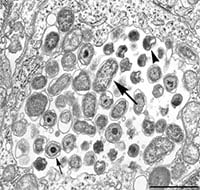Disease Specifics
Etiologic agent
Chlamydia psittaci, an intracellular gram-negative bacterium that commonly infects birds, causes psittacosis in humans.
C. psittaci, along with C. pneumoniae and C. trachomatis, are members of the bacterial family Chlamydiaceae. The Chlamydiaceae family shares a unique developmental cycle that is different from all other bacteria. C. psittaci growth consists of two alternating forms:
- Elementary bodies
- Reticulate bodies
Elementary bodies are metabolically inactive. They infect the host when the cell ingests them (receptor-mediated endocytosis). Once inside the cell, the elementary bodies differentiate into reticulate bodies, which are metabolically active but noninfectious. The reticulate bodies, which rely on the host cell for adenosine triphosphate (ATP) synthesis, divide by binary fission and induce a host immune response. After 48 to 72 hours, the reticulate bodies reorganize themselves and condense to form new elementary bodies. The elementary bodies then leave the host cell and start a new infectious cycle.
Since C. psittaci growth takes place within host cells, laboratorians cannot grow the organism using typical bacterial culture media.
Transmission
Most commonly, C. psittaci infects humans who inhale dust containing dried droppings or respiratory secretions from infected birds. Less commonly, birds infect people through bites and beak-to-mouth contact. People rarely transmit C. psittaci to other people. There is no evidence that the bacteria spread by handling or eating poultry products.

Electron micrograph of Chlamydia psittaci cells. The arrow head indicates an intermediate form, the large arrow indicates a reticulate body, and the small arrow points to an elementary body. The bar is one micron in length.
Wolff BJ. Whole genome sequences of Chlamydophila psittaci genotypes. UGA, 2012.
Risk factors
During the 1980s, public health surveillance indicated that exposure to caged pet birds accounted for 70% of the psittacosis cases for which the source of infection was known. Of these, owners of companion birds or bird fanciers were the largest group of affected persons (43%). Pet-shop employees accounted for an additional 10% of cases.
New research has shown that poultry is another important source of infection, and psittacosis outbreaks among poultry processing plant employees have been reported. Others at increased risk were persons whose occupation places them at risk of exposure, including:
- Veterinarians and veterinary technicians
- Laboratory workers
- Workers in avian quarantine stations
- Farmers
- Zoo workers
However, human infection can result from transient exposure to infected birds or their contaminated droppings. Therefore, persons with no identified avocational or occupational risk may become infected. In some reports, mammalian species have been considered to be a source of infection to humans.
- Balsamo G, Maxted AM, Midla JW, et al. Compendium of measures to control Chlamydia psittaci infection among humans (psittacosis) and pet birds (avian chlamydosis), 2017. J Avian Med Surg. 2017;31(3):262–82.
- Beeckman DSA, Vanrompay DCG. Zoonotic Chlamydophila psittaci infections from a clinical perspective. Clin Microbiol Infect. 2009;15(1):11–7.
- Chlamydophila psittaci: Pathogen safety data sheet — infectious substances, Public Health Agency of Canada, April 2013.
- Hogerwerf L, Roof I, de Jong MJK, Dijkstra F, van der Hoek W. Animal sources for zoonotic transmission of psittacosis: A systematic review. BMC Infect Dis. 2020;20(1):192.
- Psittacosis surveillance, 1975–1984. Centers for Disease Control and Prevention, June 1987.
- Wolff BJ, Morrison SS, Winchell JM. Development of a multiplex TaqMan real-time PCR assay for the detection of Chlamydia psittaci and Chlamydia pneumoniae in human clinical specimens. 2018;90(3):167–70.